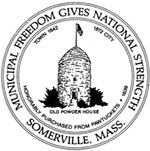Residential and commercial tax rates to be lower in FY14; Significant shift in tax burden from residents to commercial properties keeps taxes low despite rising property values

Somerville property owners are in for some good news regarding their tax bills. Real estate values in Somerville are climbing, but tax bills will hold relatively steady in fiscal year 2014 (FY14) with a decline in tax bills for some and only modest increases for most—thanks to unprecedented gains in new growth fueled mainly by new development in Assembly Square.
The residential tax rate will decrease 5.7 percent in FY2014 from $13.42 per thousand dollars of property value to $12.66 per thousand, and the commercial rate will be lowered 3.9 percent from $22.38 per thousand to $21.51. At the same time, an unprecedented shift in the tax burden from residential to commercial property owners will take effect. The share of total taxes paid by residential property owners will decrease 3 percent, more than three times the decrease in any previous year.
“We have never seen anything like this before. This is a truly historical shift, and the slightest shift of the tax burden can have a dramatic impact when you are dealing with numbers this large,” said City Assessor Marc Levye. “This will save residential owners $2.6 million next year compared to what they would have paid if their share of the tax burden remained unchanged from the previous year. Most residential owners will see either a smaller increase or an outright decrease in their tax bill. This is significant good news, and it’s due in large measure to Assembly Row.”
The city is able to reduce the tax rate due to an unprecedented $3.5 million in new growth last year—more than $1 million more than the previous year. Most of that new growth stems from new commercial and residential construction at Assembly Row. Max-Pak construction and the increased value created by renovations carried out by the Public Storage facility at 50 Middlesex Ave., the new Stop & Shop on Route 16 and new personal property growth at 50 and 70 Inner Belt Road also contributed significantly to new growth. (New growth is the value added to homes and buildings by improvements or new construction. The new taxes collected on these properties are based on the higher or newly created value.)
“This is just the beginning of the benefits that Somerville residents and businesses will reap in return for the prudent investments that the city, the Board of Aldermen and this community have been making to spur smart development in our city in recent years,” said Mayor Joseph A. Curtatone.
Curtatone has long pointed to Cambridge as the goal for distribution of the tax burden. In Cambridge, 61 percent of the tax levy is paid by businesses while residents bear only 39 percent of the tax burden. In Somerville—despite this year’s important progress—the reverse applies: more than two-thirds of the tax burden is still resting on residents while businesses contribute less than one-third.
“This must change,” said Curtatone. “Somerville property owners who receive the residential tax exemption already receive one of the lowest tax rates in the region, but that is not enough. And building affordable units alone is also not enough if we want to maintain affordability in our city. We are experiencing a historic shift toward the urban core that is driving up real estate prices metro-wide. To help maintain affordability for all Somerville residents—including the many middle and working class families that have lived here for generations—while still improving city services and investing in our schools, we must increase the commercial tax base so that we can lower the residential tax burden.”
Taxes will decline or only modestly rise for most residences despite overall increases in property values and sale prices, which led to higher assessed values for most property types as determined by the Somerville Board of Assessors and approved by the Mass. Department of Revenue. Single families saw the most significant change with an average increase of just under 12 percent in assessed value. Two- and three-family assessed values increased citywide on average by 7 percent, and average condo assessed values increased more than 4 percent. Meanwhile, in another sign of the ongoing real estate recovery in Somerville, foreclosures are down 74 percent through October 2013 over the previous year.
While property owners are gaining value from their investments in their homes, both condo owners and owners of 4-8-families will see an average decrease of $88 and $42, respectively, in their FY14 tax bill. Average increases for two- and three-family owners will be just $39 and $53, respectively. Single-families will see increases on average of $293. However, these changes also reflect an average savings of $165 per residential property for FY14 assuming the percentages of the residential and commercial tax levies stayed the same in FY13. For example, without the decrease, condo owners would on average see an increase of $77 rather than a decline of $88 had the lower tax rate not been possible. (Numbers assume a residential exemption but do not include the Community Preservation Act surcharge.)
“To lower residential taxes, we must bring in new businesses to Somerville and create the infrastructure that will attract them. That’s why the community members who developed the many value-based goals in our 20-year SomerVision plan call for doing exactly this via the kind of smart, community-guided development that we are working to realize in Assembly Row, in Union Square and Boynton Yards, in Inner Belt and eventually along McGrath,” said Curtatone. “So again, this year’s dramatic shift in the tax burden from residents to businesses is just a start, and we will hold steady to ensure our residents—all residents—reap more of these benefits in the future.”















Reader Comments